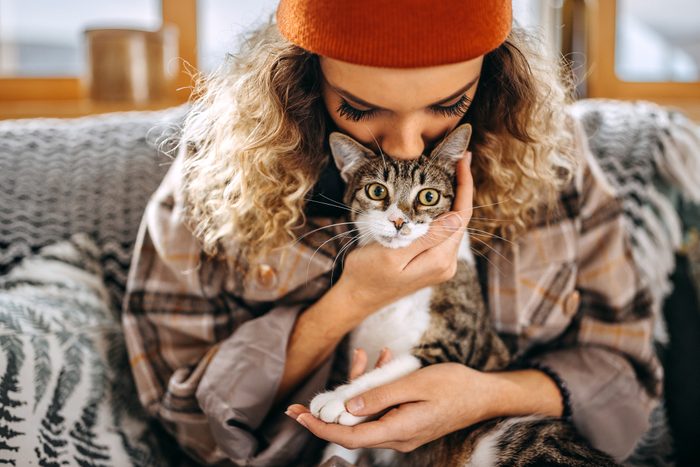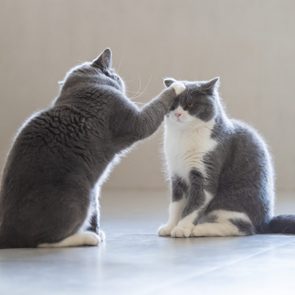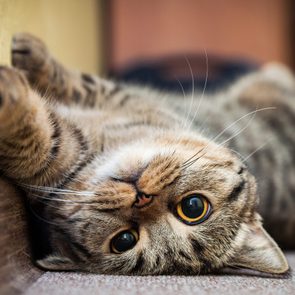Do Cats Like Kisses? What to Know Before Smooching Your Kitty
Updated: Aug. 21, 2023

Cats can go from aloof to lovey-dovey in the blink of an eye. So how can we be sure cats like being kissed? Here's what to know before you pucker up.
Cats are incredibly easy to love, especially the most affectionate cat breeds. We swoon over their cute faces and fluffy waves of fur, and we relish all the ways cats show affection—like when they hop into our lap, purring and meowing their way into our hearts. It’s so tempting to return the love by picking them up and giving them a smooch, but do cats like kisses? And do they even understand what human kisses mean? The answers lie in their cat behavior and cat body language. We spoke to cat behavior experts to hear what they have to say about kissing your cat and what you should know before you pucker up. (And if you’re a dog lover, find out how dogs really feel about being kissed.)
Get Reader’s Digest’s Read Up newsletter for pets, humor, cleaning, travel, tech and fun facts all week long.
Do cats like kisses?
Maybe you’ve never asked yourself whether or not cats like kisses, but it’s something to consider. Do cats like kisses, or are they thinking “Meow you doin’ with those lips?!”
“Kissing your cat with your lips is not something cats will understand, nor will they recognize it as a cat species-specific behavior,” says Stephen Quandt, founder of Stephen Quandt Feline Behavior Associates in New York City. Still, some cats may tolerate our kisses and possibly appreciate them, especially when your cat trusts you. They may pair kisses with other feel-good things, such as nuzzling, gently breathing warm air on them or offering your forehead for sniffing or nose touching, Quandt says. “Cats read our body language, and if we are soft and gentle with them when attempting a kiss, this may help them appreciate the attention.”
Ultimately, it depends on the cat and their personality. Some may like affection in the form of touching, petting, rubbing and even kissing, while other cats have more defined boundaries. Regardless, cats are notoriously fickle. They might be OK with a smooch in the morning but run for the hills when you attempt it later the same day.
What do cats think human kisses are?
“It depends on how the cat was socialized to humans when they were young, how comfortable they are with handling and their relationship to the person attempting to kiss them,” says Janna Skinner, a cat behavior manager at the Arizona Animal Welfare League in Phoenix.
Cats that received cuddling, kisses and other forms of socialization as kittens are more likely to tolerate kissing than a cat whose socialization didn’t include repeated up-close-and-personal contact. “Additionally, cats are more likely to accept kisses from people they know well or have a strong bond with,” says Skinner.
But how can cats know we love them, especially if they shy away from kisses? While cats can’t comprehend the emotions encompassing love the way humans do, they do know who provides their kitty meals, treats, affection and other comfort, which essentially conveys that lovin’ feeling. You’ll know your cat loves you by the things they do. “Cats primarily show affection to their humans by wanting to be near us and participate in whatever we are doing, whether it is watching television, working on a computer or doing other things around our homes,” says Skinner. Cats also show their affinity for their human much the same way they show affection to other cats—with head bunting and rubbing against your face.
Do cats kiss one another?
No. At least not in the same way humans kiss. “Many people refer to the common feline behavior of touching noses as ‘kitty kisses,’ but this is actually a form of greeting and information exchange between cats that are friendly with each other,” says Skinner. Cats aren’t locking lips, but they do show affection by head bunting (rubbing their heads against each other), cheek rubbing and the oh-so-adorable walking with their tails entwined. Mutual grooming can also be a sign of affection between some cats.
What are some signs your cat doesn’t like being kissed?
Do cats like kisses, or are kisses one of the things you do that your cat hates? There are a few ways to find out. Some signs are more subtle, but if you watch for them, they are quite obvious. Does your cat pull away when you get close to their face and pull their ears down to the side? “A cat that doesn’t appreciate kissing will likely turn away or move away from you,” says Quandt. They might also swat at your face or hiss at you. Because cats are fickle, it could depend on their mood and cattitude of the moment. But if they consistently exhibit the signs mentioned, kissing is probably off the table. “Repeatedly kissing your cat when they are not comfortable getting kisses may lead to your cat avoiding you if they think you might want to kiss them,” says Skinner.
How can you show affection for your cat without kissing it?
You’re absolutely smitten with your kitten, but what if your cat isn’t enthusiastic about your smooches? You can try a kissing alternative. “Giving a finger-to-nose touch simulates a cat’s nose-to-nose ‘kiss’ or greeting,” says Quandt. “Different cats appreciate different approaches, but generally, gentle petting, nuzzling, giving ‘scritches’ on their cheeks or foreheads are well appreciated.”
You can also pet to show affection, just first find out where cats like to be petted. Cats generally have some favorite spots, but you can observe how they react when you pet them in specific areas. “Nuzzling, purring, trilling are all nice signs, as is gently meowing,” says Quandt. Alternatively, if they rub up against you or their tail is high or it is high and quivers gently, it’s a sign of affection. “Kneading (making biscuits) is always a good sign, as that is a kitten-to-mother behavior that stimulates lactation.”
You might want to avoid one area: the floofy belly. While some cats like belly rubs, others feel threatened or uncomfortable. This potentially sensitive area may be an evolutionary trait. Here’s a fascinating cat fact: “The ‘pouch’ of loose flesh that many cats have under their bellies contains no vital organs and serves as a way of distracting an attacker so they go after a different part of their body that won’t cause fatal or serious injury,” says Quandt.
About the experts
- Stephen Quandt is the founder of Stephen Quandt Feline Behavior Associates and is a feline training and behavior specialist certified through the Animal Behavior Institute. He is a professional cat behaviorist with more than 20 years of experience working with cats in private consultations, animal shelters and rescue work with the ASPCA and Animal Care Centers of NYC. He is the owner of two cats: Jenny and Cricket.
- Janna Skinner is the feline behavior manager at the Arizona Animal Welfare League (AAWL), Arizona’s largest and oldest no-kill shelter. Skinner is a certified cat trainer from the Animal Behavior College. At AAWL, she works as a cat behavioral expert, improving behavior modifications as well as creating behavioral guidelines for cats and kittens in their care. Skinner has seven cats of her own: Meep, Painted Lady, Peanut Butter, Taco, Fleetwood, Rudy and Chopstick.



















